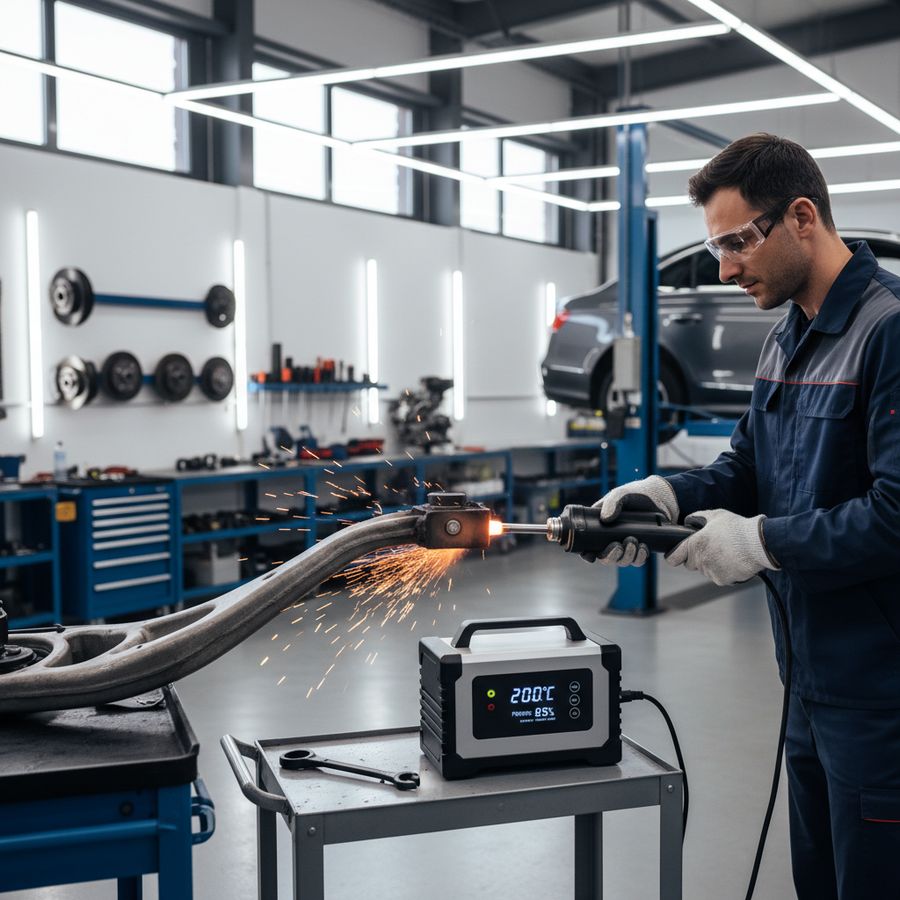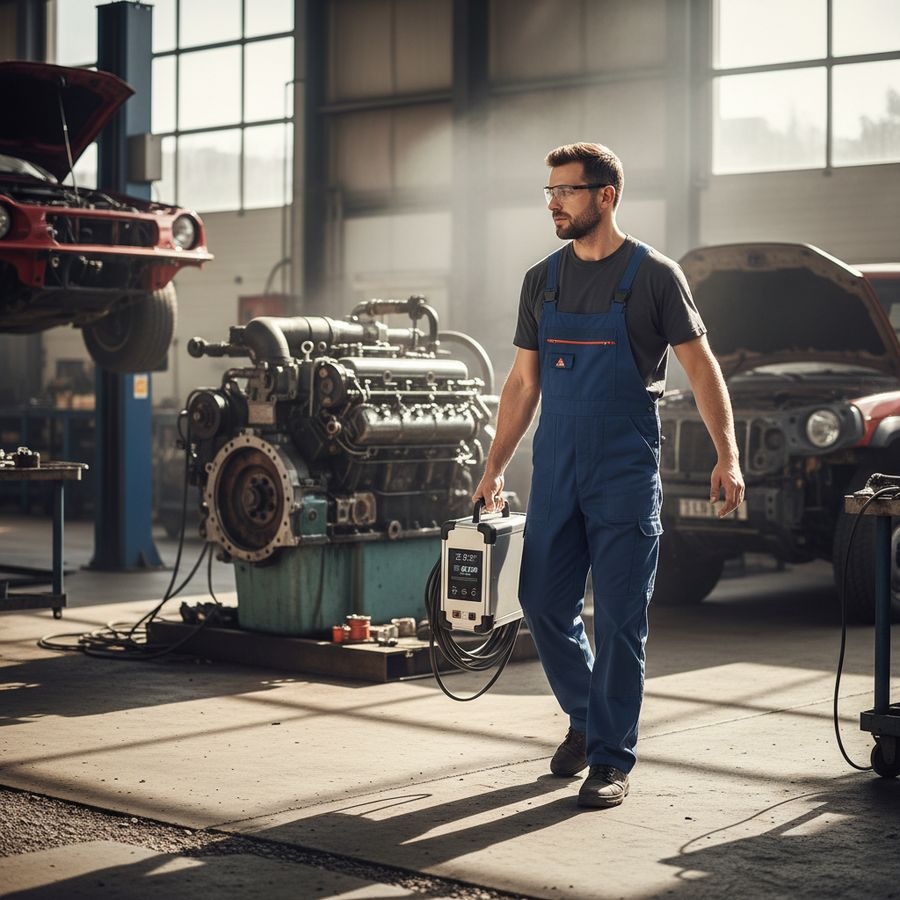Portable induction heaters: features and applications
bis Mikael Rosvall auf Nov 05, 2025

Overview
Portable induction heaters represent a significant advancement in the field of workshop tools, offering an innovative, efficient, and safe method for heating metals. Unlike conventional heating methods that rely on open flames or direct contact heating, induction heating uses electromagnetic fields to generate heat inside conductive materials. This contactless approach not only improves safety but also ensures rapid, precise heating with minimal energy waste.
At their core, portable induction heaters are compact devices designed to deliver powerful heating applications on demand, without the constraints of bulky equipment or hazardous flames. These units are engineered to be lightweight, yet robust, making them ideal for mobile use in various industrial and automotive environments. They excel in tasks such as releasing seized bolts, preheating metal parts before welding, and facilitating heat alignment in assembly processes.
Induction technology works by inducing eddy currents within the metal, which causes it to heat internally. This method is highly efficient and can target specific areas without affecting surrounding components. The portability factor adds convenience, enabling technicians and mechanics to bring heating power directly to the worksite, be it a workshop, garage, or field environment.
"Portable induction heaters revolutionize traditional heating methods by combining safety, speed, and precision in a mobile format."
Besides automotive repair shops, these heaters are also used in heavy maintenance, manufacturing, and production lines. Their versatility extends to heating any metal type, providing a universal solution for many heating challenges in mechanical and industrial settings. By eliminating the need for gas or flames, portable induction heaters contribute to a greener and cleaner workspace, aligning with modern demands for environmentally responsible tools.
In summary, portable induction heaters are indispensable tools that cater to the evolving needs of professionals requiring reliable, fast, and safe heating options. Their design and technology make them a standout choice among workshop tools for diverse heating applications.

Advantages of portability
The portability of induction heaters offers undeniable benefits that transform how heating tasks are approached in workshops and on-site repairs. The ability to easily transport and maneuver these devices means that technicians can heat components exactly where needed without the hassle of moving heavy parts or setting up cumbersome equipment.
One major advantage is the time-saving aspect. Portable units eliminate delays associated with transferring parts to stationary heaters or waiting for bulky equipment to be prepped. This efficiency reduces downtime, accelerates workflow, and ultimately cuts operational costs.
Portability also enhances workplace safety. Since these heaters do not rely on open flames or combustible fuels, the risk of fire hazards is significantly lowered. Their compact design typically integrates advanced cooling systems, which protect the device and user from overheating. This allows for longer operating periods without compromising safety or performance.
Furthermore, portable induction heaters are designed with ergonomics in mind, often featuring manageable weight and user-friendly controls. This makes handling easier, reducing operator fatigue and improving precision during applications. The flexibility to use them in confined or challenging spaces, such as under vehicles or inside machinery, is another significant benefit.
-
Quick setup and easy transportation
-
Reduced need for additional safety measures
-
Lower insurance costs due to safer operation
-
Environmentally friendly with zero gas emissions
-
Versatile use on various metals and parts
In essence, portability amplifies the overall value of induction heaters, making them not only practical but also indispensable for professionals who demand both power and convenience in their heating applications.

Common workshop applications
Portable induction heaters are widely used in workshops for numerous heating applications requiring precision and control. Their primary function revolves around heating metals quickly and safely, which is essential for tasks where traditional heating tools fall short.
One of the most common applications is releasing mechanical joints such as seized bolts, nuts, and axles. By applying focused heat, induction heaters expand the metal components, loosening rusted or corroded fasteners without damaging surrounding parts or paint. This method is far superior to using open flames or impact tools, which can cause warping or safety hazards.
In addition, these heaters are frequently employed for heat alignment processes. Precise heating can expand or soften metal parts, allowing for easier fitting and adjustment during assembly or repair. This capability is particularly valuable in automotive bodywork, heavy machinery maintenance, and production line setups.
Pre- and post-welding treatments also benefit from induction heating. By preheating metals before welding, it minimizes thermal shock and reduces the risk of cracks or weld defects. Post-weld heating can relieve stresses and improve the structural integrity of the joints.
Other notable workshop uses include:
-
Heat treating and tempering of metals
-
Removing paint or coatings without direct flame
-
Facilitating assembly of tight-fitting metal parts
-
Surface hardening and annealing applications
"Induction heaters empower workshop professionals to perform complex heating tasks with precision, speed, and unmatched safety."
Overall, portable induction heaters enhance productivity and quality in workshops by offering a flexible, clean, and efficient alternative to traditional heating methods.
Power output and cooling systems
Power output is a critical factor in the performance of portable induction heaters. These devices typically range from low to high kilowatt levels, with popular models delivering around 8 to 12 kW of power. This range ensures they have enough heating capability to tackle tough jobs such as stuck bolts or heavy metal components, while remaining compact and manageable.
The power output directly affects heating speed and penetration depth, enabling users to select the right heater for their specific workshop heating applications. Higher wattage units heat faster and can handle larger or thicker metals, while lower power models are ideal for delicate or smaller parts.
Equally important is the cooling system integrated into portable induction heaters. Because these units generate substantial electromagnetic energy and heat during operation, effective cooling is necessary to maintain consistent performance and prolong equipment lifespan.
Most portable induction heaters incorporate advanced cooling mechanisms such as:
-
Air cooling with built-in fans
-
Liquid cooling systems for enhanced heat dissipation
-
Thermal sensors to monitor and regulate temperature
These cooling systems ensure the device remains safe to handle and prevents overheating-related failures or shutdowns during prolonged use. For example, the ALESCO ACE12 model features an integrated NIX3 cooler, allowing continuous operation without compromising safety or power.
Maintenance of cooling systems is equally vital, as dust and debris can clog fans or radiators, reducing efficiency. Regular inspection and cleaning of cooling components help sustain optimal heating output and device reliability.
"Balanced power output and efficient cooling are the pillars that support the high performance and durability of portable induction heaters."
In conclusion, understanding the relationship between power output and cooling systems allows users to maximize their induction heater’s capabilities, ensuring safe, fast, and effective heating for diverse workshop needs.
User experience and handling tips
Optimizing user experience with portable induction heaters begins with understanding best practices for handling and operation. These tools are designed for ease of use, but following certain guidelines enhances safety, efficiency, and device longevity.
First, always ensure the heater is placed on a stable surface and the work area is clear of flammable materials. Since induction heating targets metal specifically, avoid contact with non-metallic objects during operation. Wearing appropriate personal protective equipment (PPE) such as gloves and safety glasses is recommended to protect against accidental burns or sparks.
Handling tips include:
-
Use the correct heating tip tailored to the metal type and size
-
Maintain a consistent distance between the coil and the metal surface for even heating
-
Monitor heating duration carefully to avoid overheating or damage
-
Allow the device’s cooling system to operate fully, especially during extended use
-
Keep cables and connectors dry and free from mechanical stress
Many users appreciate the lightweight design of portable induction heaters, such as units weighing under 20 kg, which facilitates easy transport and operation even in tight spaces. The intuitive controls and clear displays on modern models simplify adjustments and monitoring.
"Proper handling and respect for the equipment’s capabilities ensure a safe and productive experience when using portable induction heaters."
Finally, regular maintenance, including checking for wear and tear on cables, coils, and cooling components, is essential. Following manufacturer instructions and safety protocols will not only protect the user but also extend the functional life of the heater, making it a reliable asset in any workshop.
Conclusion
Portable induction heaters are invaluable workshop tools that offer a combination of safety, efficiency, and versatility for various heating applications. Their contactless heating technology, powered by precise electromagnetic induction, provides a superior alternative to traditional flame-based or resistive heating methods.
The portability factor adds significant practical benefits, including quick deployment, enhanced safety due to the absence of open flames, and flexibility to perform tasks directly on-site. Whether releasing seized mechanical joints, preheating metals for welding, or conducting heat alignment, these heaters simplify complex tasks and improve overall workflow.
Power output and cooling systems are key design features that dictate heater performance and durability. Modern portable induction heaters balance robust power delivery with effective thermal management, ensuring consistent operation even under demanding conditions.
Emphasizing user experience and proper handling maximizes the potential of these devices, allowing professionals to safely harness their capabilities while protecting their investment. Regular maintenance and adherence to best practices are essential for long-term reliability.
In a market that prioritizes environmental responsibility and workplace safety, portable induction heaters emerge as a progressive solution. They help lower carbon emissions, remove gas and flame hazards, and foster cleaner, safer workshop environments. To learn more about these innovative heaters, visit Induktion Store.
"Embrace portable induction heaters to revolutionize your heating processes—boost productivity, enhance safety, and support sustainable practices in your workshop."
Investing in a quality portable induction heater is not just about acquiring a tool; it’s about adopting a smarter, safer, and more efficient approach to metal heating challenges in today’s industrial and automotive sectors.




